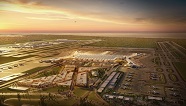2026 Autumn Budget event industry asks, event inclusion, and more
This month’s news highlights industry 2026 Autumn Budget asks, an industry driven by growth, accountability and inclusion. From economic gains to new standards and support...
Istanbul New Airport, on shores of the Black Sea, will serve 90 million passengers annually in its first phase. At its completion in 10 years, it will occupy nearly 19,000 acres and serve up to 200 million travellers a year with six runways. That’s almost double the traffic at world’s biggest airport currently, Atlanta’s Hartsfield-Jackson. The airport’s interiors nod to Turkish and Islamic designs, and its tulip-shaped air traffic control tower won the 2016 International Architecture Award. It also uses mobile applications and artificial intelligence for customers, is energy efficient and boasts a high-tech security system.
All aviation operations will move there at the end of December when Istanbul’s main international airport, named after Turkey’s founder Mustafa Kemal Ataturk, is closed down. Ataturk Airport now handles 64 million people a year. On the Asian side of the city, Sabiha Gokcen Airport handled 31 million passengers last year. It will remain open.
Tens of thousands of workers have been scrambling to finish the airport to meet Erdogan’s Oct. 29 deadline. Protests in September over poor working conditions and dozens of construction deaths have highlighted the human cost of the project.
Istanbul New Airport, on shores of the Black Sea, will serve 90 million passengers annually in its first phase. At its completion in 10 years, it will occupy nearly 19,000 acres and serve up to 200 million travellers a year with six runways. That’s almost double the traffic at world’s biggest airport currently, Atlanta’s Hartsfield-Jackson. The airport’s interiors nod to Turkish and Islamic designs, and its tulip-shaped air traffic control tower won the 2016 International Architecture Award. It also uses mobile applications and artificial intelligence for customers, is energy efficient and boasts a high-tech security system.
All aviation operations will move there at the end of December when Istanbul’s main international airport, named after Turkey’s founder Mustafa Kemal Ataturk, is closed down. Ataturk Airport now handles 64 million people a year. On the Asian side of the city, Sabiha Gokcen Airport handled 31 million passengers last year. It will remain open.
President of Turkey Recep Tayyip Erdogan has unveiled Istanbul New Airport, a mega project that may eventually become the world’s largest air-transport hub on the 95th anniversary of Turkey’s establishment as a republic. It’s a symbolic launch, as only limited flights will begin days later and a full schedule of service won’t take place until the end of the year.
Tens of thousands of workers have been scrambling to finish the airport to meet Erdogan’s Oct. 29 deadline. Protests in September over poor working conditions and dozens of construction deaths have highlighted the human cost of the project.
Istanbul New Airport, on shores of the Black Sea, will serve 90 million passengers annually in its first phase. At its completion in 10 years, it will occupy nearly 19,000 acres and serve up to 200 million travellers a year with six runways. That’s almost double the traffic at world’s biggest airport currently, Atlanta’s Hartsfield-Jackson. The airport’s interiors nod to Turkish and Islamic designs, and its tulip-shaped air traffic control tower won the 2016 International Architecture Award. It also uses mobile applications and artificial intelligence for customers, is energy efficient and boasts a high-tech security system.
All aviation operations will move there at the end of December when Istanbul’s main international airport, named after Turkey’s founder Mustafa Kemal Ataturk, is closed down. Ataturk Airport now handles 64 million people a year. On the Asian side of the city, Sabiha Gokcen Airport handled 31 million passengers last year. It will remain open.

President of Turkey Recep Tayyip Erdogan has unveiled Istanbul New Airport, a mega project that may eventually become the world’s largest air-transport hub on the 95th anniversary of Turkey’s establishment as a republic. It’s a symbolic launch, as only limited flights will begin days later and a full schedule of service won’t take place until the end of the year.
Tens of thousands of workers have been scrambling to finish the airport to meet Erdogan’s Oct. 29 deadline. Protests in September over poor working conditions and dozens of construction deaths have highlighted the human cost of the project.
Istanbul New Airport, on shores of the Black Sea, will serve 90 million passengers annually in its first phase. At its completion in 10 years, it will occupy nearly 19,000 acres and serve up to 200 million travellers a year with six runways. That’s almost double the traffic at world’s biggest airport currently, Atlanta’s Hartsfield-Jackson. The airport’s interiors nod to Turkish and Islamic designs, and its tulip-shaped air traffic control tower won the 2016 International Architecture Award. It also uses mobile applications and artificial intelligence for customers, is energy efficient and boasts a high-tech security system.
All aviation operations will move there at the end of December when Istanbul’s main international airport, named after Turkey’s founder Mustafa Kemal Ataturk, is closed down. Ataturk Airport now handles 64 million people a year. On the Asian side of the city, Sabiha Gokcen Airport handled 31 million passengers last year. It will remain open.